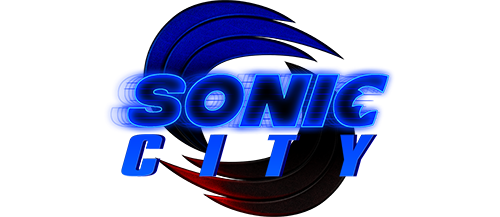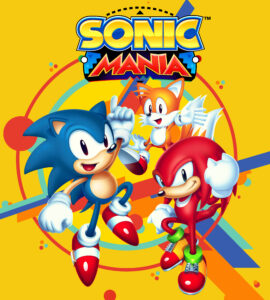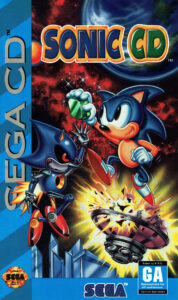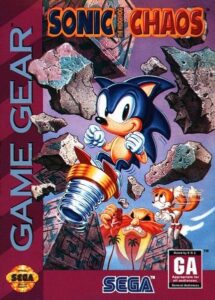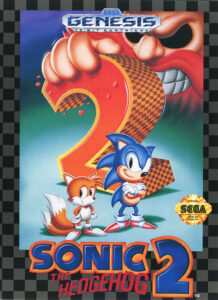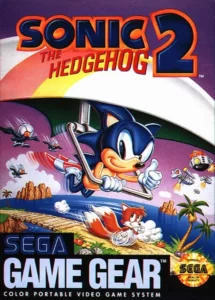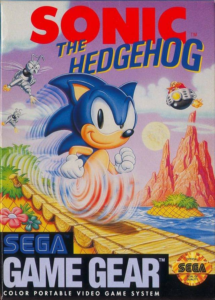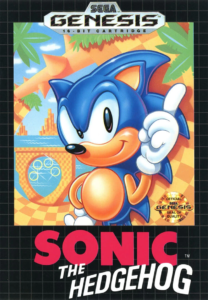in: Games
Sonic Adventure 2
Sonic Adventure 2 (ソニックアドベンチャー2 Sonikku Adobenchā Tsū) is a platform game developed by Sonic Team and published by Sega in 2001 for the Dreamcast, as part of the Sonic the Hedgehog series. It serves as the sequel to Sonic Adventure and was developed to celebrate the franchise’s tenth anniversary. Notably, it is the last Sonic title released on a Sega console. The game features two parallel storylines, each with three playable characters who share gameplay styles with their counterparts. Sonic Adventure 2 marks the debut of Shadow the Hedgehog, a character resembling Sonic, and Rouge the Bat, a mysterious treasure hunter.
In Sonic Adventure 2, Sonic is wrongfully arrested by the Guardian Units of Nations (G.U.N.) military organization, accused of stealing a Chaos Emerald. He discovers that the real thief is Shadow, a new adversary, and learns of Dr. Eggman’s plan to use a planet-shattering weapon to conquer the world. Sonic teams up with his friends Tails, Knuckles, and Amy to thwart the villains’ schemes and clear his name.
The game received positive reviews for its gameplay variety, visuals, and music. However, it was criticized for not addressing some of the flaws from its predecessor, particularly issues with the camera. Released near the end of the Dreamcast’s lifespan, it sold around 500,000 copies. Less than a year later, the game was re-released for the Nintendo GameCube as Sonic Adventure 2: Battle. This version included several enhancements to graphics and gameplay features.
Sonic Adventure 2
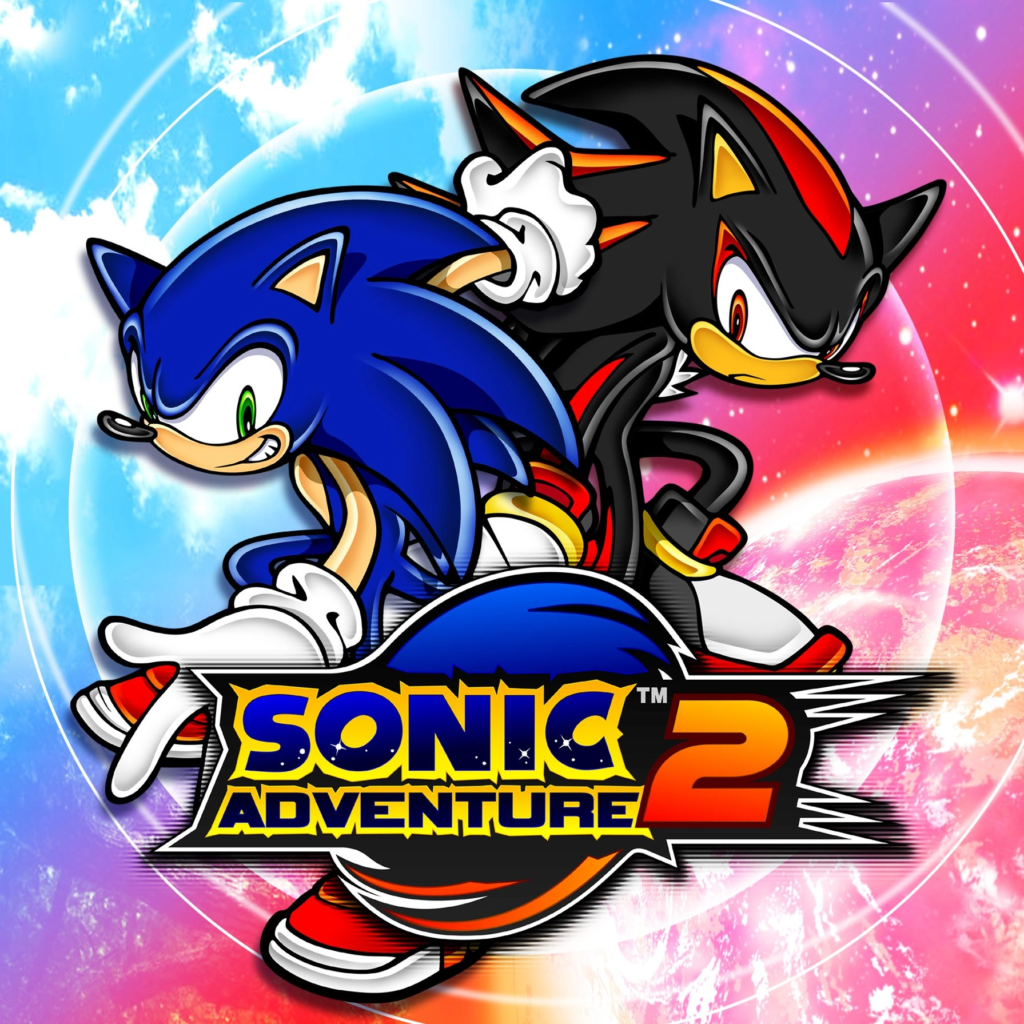
Development Staff
Developer(s)
Sonic Team USA
Publisher(s)
Director(s)
Takashi Iizuka
Producer(s)
Designer(s)
- Takashi Iizuka
- Eitaro Toyoda
- Kazuyuki Hoshino
Programmer(s)
Tetsu Katano
Artist(s)
- Kazuyuki Hoshino
- Yuji Uekawa
Writer(s)
Shiro Maekawa
Composer(s)
- Jun Senoue
- Kenichi Tokoi
- Fumie Kumatani
- Tomoya Ohtani
Video Game Overview
Series
Sonic the Hedgehog series
Release date(s)
NA June 19, 2001[1]Updated Dreamcast release list. Gamespot (June 4, 2001). Retrieved on March 14, 2024.
INT June 23, 2001[2]SONIC ADVENTURE 2. Sega (December 11, 2001). Archived from the original on December 11, 2001. Retrieved on June 18, 2019.
Genre(s)
- Platformer
- Action
- Third-person shooter
Mode(s)
Single-player, multiplayer
Rating(s)
Platform(s)
Dreamcast
Media
GD-ROM
Input
Dreamcast controller
| Preceded by |
|---|
| Sonic Adventure |
Plot
Storylines
Hero Story
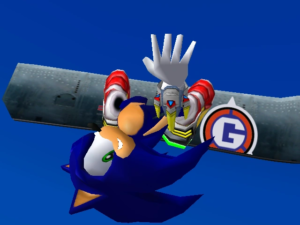
The game begins with Sonic being transported by a helicopter from Sigma-Alpha 2, a subdivision of the Guardian Units of Nations (G.U.N.) military. Sonic breaks free, jumps out of the helicopter, and uses a torn-off piece of the wing as a snowboard to escape through the city. He defeats the F-6t Big Foot mech but encounters Shadow the Hedgehog, who has stolen a green Chaos Emerald from the national reserve bank. Mistaken for Shadow, Sonic is re-captured after Shadow uses Chaos Control to warp away.
In the desert, Knuckles the Echidna and Rouge the Bat are fighting over the Master Emerald. Dr. Eggman appears, grabs the Emerald, and Knuckles shatters it to prevent Eggman from taking it. Knuckles vows to find the pieces and repair the Emerald. Meanwhile, Tails flies to Prison Island to rescue Sonic and encounters Eggman threatening Amy Rose. Tails and Eggman fight, ending in a stalemate, and Eggman leaves. Tails frees Sonic from his cell, and they escape the island just before it explodes.
Returning to the city, Eggman broadcasts a message proclaiming himself the ruler of the planet and demonstrates his power by destroying half of the moon with the Eclipse Cannon on the Space Colony ARK. Sonic and his friends realize they need to stop Eggman and decide to use Tails’ fake Chaos Emerald to sabotage the Cannon. They track Eggman to his desert base, fight through its defenses, and launch into space.
On the ARK, the heroes plan to use the fake Emerald to reverse the Cannon’s energy flow. They face various challenges, including a confrontation with Eggman, who captures Amy and demands Sonic hand over the Chaos Emerald. Sonic is tricked into an escape pod set to blow up, but he uses Chaos Control to escape. Tails fights Eggman but fails to stop him from obtaining the last Chaos Emerald.
Sonic reaches the Eclipse Cannon and faces Shadow in a final showdown. He manages to place the fake Emerald into the Cannon, causing it to explode. Sonic is seen giving a thumbs up from atop the exploding Cannon, having saved the day.
Dark Story
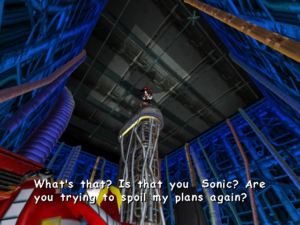
Dr. Eggman breaks into Prison Island, searching for a top-secret military weapon created by his grandfather, Professor Gerald Robotnik. The military had shut down this weapon due to its feared power. Eggman eventually locates it in a stasis capsule and unlocks it by entering the password “MA-RI-A” and inserting a gray Chaos Emerald into a console. The capsule reveals a jet black and red hedgehog, whom Eggman initially mistakes for Sonic but quickly realizes is different. The hedgehog introduces himself as Shadow, thanks Eggman for freeing him, and promises to grant him one wish. Shadow then effortlessly defeats the B-3x Hot Shot mech sent to capture them. Impressed, Eggman asks about the wish, but Shadow instructs him to gather more Chaos Emeralds and meet him in the control room on the Space Colony ARK.
In the desert, Knuckles the Echidna and Rouge the Bat are battling for the Master Emerald. Eggman interrupts, snatching the Emerald with a claw. In response, Knuckles shatters the Emerald into pieces to prevent Eggman from taking it. Rouge is furious, claiming all the world’s gems belong to her, but Knuckles insists he can find and repair the pieces. They go their separate ways, with Eggman returning to his base and Rouge searching for shards, vowing revenge on both.
Eggman arrives at his desert base, clears out the G.U.N. forces, and accesses his computer, finding a news broadcast. It reveals that Shadow has broken into the national reserve bank and stolen the green Chaos Emerald, but authorities mistakenly believe Sonic is responsible. Meanwhile, Shadow watches from a bridge and experiences a flashback of himself and Maria Robotnik fleeing from G.U.N. on the ARK. Maria is shot and, before dying, seals Shadow in an escape pod, asking him to share a promise. Shadow interprets this as a promise for revenge and flees across the highway, breaking through G.U.N.’s forces. He encounters Sonic, who is also evading military capture. Sonic realizes what is happening and attacks, but Shadow uses Chaos Control to warp away, introducing himself as the world’s ultimate lifeform before vanishing. Sonic is then captured by G.U.N.
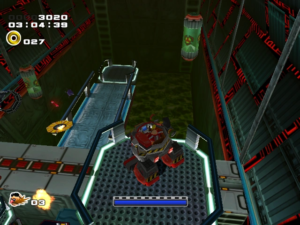
Back in the desert, Rouge infiltrates Eggman’s base and reaches the computer room, discovering a teleporter to the ARK. Curious about his plans, she continues to investigate. On the ARK, Eggman finds the main control room where Shadow is waiting. Shadow explains that the ARK, built by Gerald Robotnik, was not only the first space colony but also the birthplace of many lethal weapons, including the Eclipse Cannon, a laser capable of destroying planets. However, the cannon needs all seven Chaos Emeralds to function. Shadow offers Eggman a deal: if he helps reactivate the cannon, Eggman can use it to take over the world. Eggman agrees, thrilled at the prospect.
Rouge then appears, offering to help track down the Chaos Emeralds in exchange for keeping the Master Emerald. Eggman agrees, and Rouge provides the blue Chaos Emerald. The trio heads to Prison Island, where Rouge believes the purple, red, and turquoise Chaos Emeralds are stored. Their plan involves Eggman creating a distraction, Rouge retrieving the Emeralds, and Shadow planting time bombs.
During their operation, Amy mistakes Shadow for Sonic and hugs him, but quickly realizes her mistake. Eggman assures Shadow and Rouge that he can handle Amy. Tails, flying nearby in the Cyclone, sees Amy in danger and confronts Eggman, resulting in a stalemate. Eggman proceeds with his distraction while Shadow sets the bombs and Rouge retrieves the Emeralds. However, Rouge becomes trapped in the vault after defeating the R-1/A Flying Dog mech. With time running out, Shadow decides to save her, fighting Sonic on the way. He breaks open the vault and uses Chaos Control to transport them to safety just before the bombs detonate.
Back on the ARK, Shadow recalls a conversation with Maria about Earth before Rouge interrupts him. She is surprised he saved her, but Shadow claims he was only interested in the Chaos Emeralds. Eggman announces that they are ready, but Rouge points out they still need the yellow Chaos Emerald. Shadow reassures her that they have enough to demonstrate the Eclipse Cannon’s power. Eggman broadcasts a message to the world, using the cannon to destroy half of the moon, and demands submission within one day.
Despite their success, Shadow notes they still need the final Chaos Emerald to fully charge the cannon. Rouge reveals that Tails has the last Emerald, awarded for saving Station Square. Eggman and Shadow leave to retrieve it, while Rouge monitors them. Rouge tracks Tails, who is following the president with Sonic in the Cyclone. She alerts Shadow, but he fails to stop them. Eggman uses radar to track them and readies the Egg Golem to attack, but Sonic disables it, allowing the heroes to hijack a rocket to space.
With limited time until the cannon fires, Eggman asks Rouge for the ARK’s password. She tricks him, enters “MA-RI-A” into the console, and accesses Project Shadow files, learning that Shadow was designed as the ultimate lifeform. During her research, the heroes’ rocket hits an asteroid, releasing Master Emerald shards into space. Knuckles and Rouge fight over the shards, but Knuckles saves her from falling into lava, and they make peace. Knuckles restores the Master Emerald and returns it to the desert shrine.
On Earth, Eggman and Shadow work in the pyramid base, tracking two Chaos Emeralds. Eggman beams to the ARK, leaving Shadow to finish their plan. Eggman captures Amy and lures Sonic and Tails, demanding their Chaos Emeralds. Sonic gives a fake Emerald but is trapped in an escape pod set to explode. Sonic encourages Tails and Amy to stay strong before the pod launches and explodes. Believing Sonic dead, Tails vows to stop Eggman but is defeated, allowing Eggman to collect all seven Emeralds.
With 21 minutes until the cannon fires, Shadow is shocked to find Rouge has betrayed them and is a government spy. She reveals the true ultimate lifeform differs from Shadow, causing him to question his identity. They receive a call from Eggman, who orders Shadow to stop the intruders. Shadow confronts Rouge, who reveals the password “MA-RI-A” and doubts his memories. Shadow asserts that fulfilling Maria’s wish is his priority.
Shadow rushes across the ARK and encounters Sonic, who survived using Chaos Control. They battle fiercely, but Sonic reaches the Eclipse Cannon and sabotages it with the fake Emerald, destroying it. In the control room, Eggman places the yellow Chaos Emerald, but alarms start blaring, indicating a critical malfunction.
Last Story
Kicking off from the end of both the Hero and Dark Stories, Eggman frantically searches through the computer, trying to figure out what is going wrong. To his shock, he discovers a video containing a message from Gerald Robotnik. In the research center, Sonic and Knuckles investigate the rumbling when Rouge drops in, revealing that the ARK is now falling to Earth at terminal velocity and that they are all going to die. Suddenly, a video is broadcast to the whole world, showing Gerald in a cell on Prison Island a few days before his execution. He explains that the ARK will crash into Earth in 27 minutes, causing an explosion that will destroy the planet. This protocol was activated when Eggman inserted the Chaos Emeralds into the console, as Gerald’s posthumous revenge for G.U.N.’s raid on the ARK 50 years earlier, which resulted in Maria Robotnik’s death and drove him insane.
Eggman arrives and identifies the figure in the video as Gerald. Knuckles angrily accuses Eggman of orchestrating the catastrophe, but Eggman insists he would have done it long ago if he could. Sonic remarks on Knuckles’s poor shuttle piloting skills, annoying Eggman. Eggman then hands Rouge a hard drive containing Gerald’s diary, which she plugs into the computer and reads aloud:
I don’t quite know what happened, or what went wrong. Was it a mistake to create the ultimate lifeform? I thought it would be something that would benefit mankind… But then the military guards landed on the Colony that day. They were sent to destroy the research project that I had been working on. My colleagues at the research facility, my granddaughter Maria, I hope you are all safe.
Gerald’s voice then continues:
The colony was completely shut down, probably to prevent the prototype from falling into the wrong hands. The ARK was shut down under the premise that there had been an accident. I found Maria’s name among those who died when the ARK was shut down. She meant everything to me! And I couldn’t bear the thought that she died because of my research. I lost everything! I had nothing more to live for! I went insane! All I could think about was to avenge her! Somehow, someway, I got scared as I no longer was able to control my thoughts. All I could think about was that I wanted it all to end. Based on my original projections, I was able to complete my project, Shadow. I designed its mind to be perfect, pure… I will leave everything, to him. If you wish, release and awaken it to the world if you wish to fill it with destruction.
Eggman explains that the energy from the Chaos Emeralds overcharged the Eclipse Cannon, making the core highly reactive and unstable. If the ARK crashes, the planet will be destroyed, so they must stop the energy flow. Rouge suggests using the Master Emerald, which is stronger than all seven Chaos Emeralds combined, to neutralize the energy. The five of them rush to the Cannon’s Core. Along the way, Amy finds Shadow 19 minutes before impact. She pleads with him to help, but Shadow initially refuses, believing that humanity’s destruction is what Maria wanted. Amy begs him to reconsider, arguing that while some humans are selfish, most have good hearts and do not deserve to die.
Shadow then experiences a hidden memory and realizes that Maria’s true wish was for humanity to be happy. He vows to fulfill her true promise and joins the others. They reach the core, designed after the altar of the Master Emerald, but encounter the Biolizard, a prototype ultimate lifeform. Shadow battles the Biolizard while the others retrieve the Emeralds from the control room. Shadow defeats the Biolizard, but it uses Chaos Control to fuse with the ARK, becoming the Finalhazard. Eggman explains that the creature is determined to keep the ARK on its collision course.
Sonic and Shadow use the Chaos Emeralds to transform into Super Sonic and Super Shadow. Together, they defeat the Finalhazard and use Chaos Control to warp the ARK back into orbit. However, Shadow, unable to maintain his super form any longer, falls to Earth. Before he does, he affirms that he has fulfilled Maria’s promise.
As humanity celebrates, the others on the ARK look down to Earth. When Sonic returns, Rouge asks about Shadow, but Sonic indicates that Shadow did not survive, assuring her that he died a hero. Eggman reflects on Gerald’s intentions, questioning if he truly wanted to destroy everything. Tails is uncertain, but everyone celebrates their survival. Knuckles asks Rouge about her plans, and she replies that she is no longer interested in jewels but has a new career plan. Sonic, thinking of Shadow, assures Amy that he is fine. The charges against Sonic and the others are dropped, and Sonic promises to remember Shadow’s heroic sacrifice.
Characters
| Artwork | Character | Biography |
|---|---|---|
 | Sonic the Hedgehog | The fastest hedgehog on earth has a little competition. Mistaken for an escapee, Sonic is being chased by a secret military organization. He’ll have to catch up with the mysterious black hedgehog in order to thwart Dr. Eggman’s latest plan to conquer the world.[3]Sonic Adventure 2 (Dreamcast) United States instruction booklet, pg. 6. |
 | Shadow the Hedgehog | The black hedgehog that resembles Sonic. Shadow is the ultimate lifeform created by Professor Gerald. Shadow has a special ability called “Chaos Control,” which allows him to warp time and space using Chaos Emeralds. After telling Dr. Eggman about the existence of the Eclipse Cannon, Shadow encourages Dr. Eggman to join up and help conquer the world.[4]Sonic Adventure 2 (Dreamcast) United States instruction booklet, pg. 7. |
 | Miles “Tails” Prower | This fox boy with two tails can create mechanical inventions that rival those of made by Dr. Eggman. This time, Tails pilots his latest walker, “Cyclone.” He will support Sonic completely with his mechanical abilities.[5]Sonic Adventure 2 (Dreamcast) United States instruction booklet, pg. 8. |
 | Dr. Eggman | Also known as Dr. Robotnik, Dr. Eggman is a self-proclaimed genius. He is an evil scientist with an IQ of 300. A renowned authority on robotics, Eggman joins forces with Shadow and Rouge in a plot to conquer the world. Once he has collected the Chaos Emeralds, he plans to take care of his lifelong rival, Sonic, once and for all.[6]Sonic Adventure 2 (Dreamcast) United States instruction booklet, pg. 9. |
 | Knuckles the Echidna | The guardian of the Master Emerald, Knuckles takes his residence on the floating Angel Island. He is known as a treasure hunter, but is a skilled martial artist as well. Ever since the Master Emerald was shattered, Knuckles has made it his mission to collect each every shattered piece.[7]Sonic Adventure 2 (Dreamcast) United States instruction booklet, pgs. 10. |
 | Rouge the Bat | As a hunter who devotes her life to the pursuit of jewels, Rouge is determined to make herself rich. She is passionate about her work, and once she’s set her sights on a new treasure, she stops at nothing until she gets it. In order to collect the many pieces of the Master Emerald, she offers to help Shadow and Dr. Eggman—but her true identity remains a mystery to them both.[8]Sonic Adventure 2 (Dreamcast) United States instruction booklet, pgs. 11. |
 | Amy Rose | A cheerful girl full of passion who loves to chase after Sonic wherever he goes. Learning that Sonic was arrested by the military troops, she comes to Prison Island alone. She has a strong sense of intuition and a pure heart.[9]Sonic Adventure 2 (Dreamcast) United States instruction booklet, pg. 12. |
 | Maria Robotnik | A beautiful and mysterious girl that exists in the memory of Shadow, Maria is the granddaughter of Professor Gerald and a cousin of Dr. Eggman. |
| Prof. Gerald Robotnik | A brilliant scientist and Dr. Eggman’s grandfather. Noted as one of the most brilliant minds of all time, Professor Gerald designed the world’s first space colony “ARK.” He was also involved in the development of the ultimate life form: “Project Shadow.” He later disappeared under mysterious circumstances. |
Gameplay
Sonic Adventure 2, like its predecessor, is a 3D third-person action platformer. The game features two storylines, “Hero” and “Dark,” and players can progress through either at any time. In the Hero story, players control Sonic, Knuckles, and Tails, while the Dark story involves Shadow, Rouge, and Dr. Eggman. Each character’s gameplay is similar to their counterpart in the opposite storyline. The game consists of stages where players control one of these characters, and each stage includes boss battles. To complete the main storyline, players must finish both Hero and Dark modes, unlocking an extra story where almost all characters are used.
The objective in Sonic Adventure 2 is to reach the end of stages while a timer records the time taken. Characters collect Rings, which protect them from enemies and obstacles; losing all Rings upon being hit, and losing a life if hit without Rings. Instant deaths occur from drowning, being crushed, or falling into pits. Checkpoints provide power-ups based on the number of Rings collected. At the end of each stage, players receive a score and a letter grade based on their performance, with A being the highest.
Each Action Stage has five missions: completing the level, collecting 100 Rings, finding a lost Chao, finishing within a time limit, and completing a Hard mode version. Completing all missions and achieving A ranks earns Emblems, with a total of 180 in the game. Collecting all Emblems unlocks a Green Hill Zone remake.
Chao, small creatures from Sonic Adventure, return and can be raised in Chao Gardens. Their appearance and alignment change based on the character’s treatment. Chao treated well by Hero characters or poorly by Dark characters become Hero Chao, while those treated well by Dark characters or poorly by Hero characters become Dark Chao.
Character-Specific Gameplay
High-Speed Action Stages
Sonic and Shadow’s gameplay in Sonic Adventure 2 mirrors Sonic’s style from Sonic Adventure. Both characters are the fastest in their respective storylines, capable of using a Spin Dash to rapidly gain speed and a Homing Attack to target and strike enemies or obstacles. Their stages conclude when they touch a Goal Ring.
Sonic and Shadow can also upgrade their abilities by collecting Level Up Items. With the Light Speed Shoes (Sonic) or Air Shoes (Shadow), they can perform the Light Speed Dash. Finding the Ancient Light allows them to execute the Light Speed Attack. Additionally, obtaining the Flame Ring enables Sonic and Shadow to use the Fire Somersault.
Lock-On Shooting Stages
Tails and Dr. Eggman in Sonic Adventure 2 have gameplay styles similar to E-102 Gamma from Sonic Adventure. They pilot the Cyclone and the Eggwalker, respectively, and utilize a Health Gauge that is replenished by collecting rings. If the Health Gauge is depleted, the player loses a life or gets a Game Over if they run out of lives. Despite their slow movement and limited jumping ability, Tails and Eggman can target enemies and obstacles using the Lock-on function and destroy them with the Lock-On Missile. They can also use the Volkan Cannon, a mini-gun that is less effective than the Lock-On Missile.
Both characters can upgrade their abilities by collecting Level Up Items. The Bazooka (Tails) or Large Cannon (Eggman) increases the power of the Volkan Cannon. The Booster (Tails) or Jet Engine (Eggman) enables hovering. The Laser Blaster enhances the Lock-On Missile by causing explosive damage to nearby enemies. Additionally, Eggman can collect Protective Armor to increase the durability of his Eggwalker.
Hunting Stages
Knuckles and Rouge share the same gameplay style as Knuckles from Sonic Adventure. Players control them to find three Master Emerald shards or similar objects hidden within each stage. The Emerald Radar helps locate these hidden objects by indicating proximity. Although Knuckles and Rouge are slightly slower than Sonic and Shadow, they can glide to descend slowly and traverse large gaps. When they hit a vertical wall while gliding, they can climb it, allowing them to scale the wall. Additionally, they can dig into solid ground to uncover buried objects.
Scoring System
In Sonic Adventure 2, players can earn points through various actions:
- Rings: Collecting a ring adds 10 points to the score.
- Tricks: From Sonic Adventure 2 onwards, performing tricks and Trick Actions in specific areas or after jumping off gimmicks like rails or ramps can earn points, with a maximum of 1000 points per trick.
- Objects: Destroying objects such as wooden boxes grants 20 points per destroyed object.
- Emerald Shards: Points for finding objective items (Emerald Shards, Chaos Emeralds, gate keys) depend on the speed of collection, decreasing with the use of Hint Boxes. The first item’s score is based on the stage’s elapsed time, while subsequent items depend on the time taken since the last item. The highest score is 2000 points for finding an item within one minute, plus a base score of 500 points.
- Lock-on: Points increase based on the number of enemies and targets locked onto at once, with a maximum of 2000 points for eleven or more lock-ons.
- Enemies: Points vary by enemy type. For example, defeating the Gold Beetle, one per level, awards 1000 points. Chains of defeated enemies, particularly in stages involving Eggman and Tails, yield additional points.
- Time Bonus: Calculated as (10000 – 20 \times N), where (N) is the number of seconds elapsed after the first minute of the stage.
Score Classes
Enemies
| Enemy | Score |
|---|---|
| Artificial Chaos P-1 | 200 |
| Artificial Chaos P-100 | 200 |
| Blue Eagle | 500 |
| Bomb Beetle | 100 |
| Bomb Wing | 500 |
| Boo | 100 |
| Boom Boo | 300 |
| Buzz Bomber | 100 |
| Cell | 10 |
| Chopper | 100 |
| E-1000 | 200 |
| Float Type | 200 |
| Gohla | 100 |
| Gold Beetle | 1000 |
| Guard Type | 200 |
| Gum Hawk | 200 |
| Gun Beetle | 100 |
| Gun Hawk | 200 |
| Gun Hunter | 100 |
| Gun Wing | 500 |
| Hornet-3 | 100 |
| Hornet-6 | 200 |
| Hornet-9 | 300 |
| Kiki | 100 |
| Laser Hawk | 200 |
| Laser Hornet | 100 |
| Laser Hunter | 100 |
| Mono Beetle | 100 |
| Phoenix | 100 |
| Rhino Cannon | 100 |
| Rhino Jet | 100 |
| Rhino Metal | 100 |
| Rhino Spike | 100 |
| Shield Hunter | 200 |
| Sky Hawk | 500 |
| Spark Beetle | 100 |
| Spring Beetle | 100 |
| Unidasu | 100 |
Controls
General
| Button Formation | Movement |
|---|---|
| Move | |
| Jump | |
| Action | |
| Switch Action Window | |
| L / R | Rotate camera |
| START | Pause |
High-Speed Action Stages
| Button Formation | Movement | |
|---|---|---|
| Somersault | ||
| Hold | Spin Dash | |
| Jump > | Homing Attack | |
| Crouch to accelerate | ||
| Light Speed Dash | ||
| Jump > | Bounce Attack | |
Lock-On Shooting Stages
| Button Formation | Movement | |
|---|---|---|
| Volkan Cannon | ||
| Hold | Lock-on | |
| Lock-on > release | Lock-On Missile | |
| Propeller Punch | Punch | |
| Jump > Hold | Hover | |
Hunting Stages
| Button Formation | Movement | |
|---|---|---|
| Punch | Kick | |
| Hold | Glide | |
| Glide into wall > | Climb Wall | |
| Swim up and down | ||
| Dig | ||
Objects
Items
- Air bubble
- Chao Egg
- Chao Key (first appearance)
- Chaos Emerald
- Chaos Drive (first appearance)
- Container(first appearance)
- Cage (first appearance)
- Chao Container (first appearance)
- Steel Container (first appearance)
- Unbreakable Container (first appearance)
- Wooden Container (first appearance)
- Emblem
- Emerald Shard
- Floating Item Box (first appearance)
- Gate key (first appearance)
- Goal Ring (first appearance)
- Item Box
- 1-Up
- 5 Rings
- 10 Rings
- 20 Rings
- Bomb
- Health (first appearance)
- High-Speed Shoes
- Invincibility
- Magnetic Shield
- Shield
- Key Stone
- Gate Key (first appearance)
- Meteorite (first appearance)
- Outfit (first appearance)
- Ring
- Snowboard
Gimmicks and Obstacles
- Ancient Ruin (first appearance)
- Ball Switch
- Bungie Vine (first appearance)
- Dash Panel
- Dynamite (first appearance)
- Egg Beetle (first appearance)
- Gravity Control Switch
- Green energy fluid (first appearance)
- Grind Rail (first appearance)
- GUN Military Truck (first appearance)
- High-speed warp tube
- Hint Box
- Hourglass (first appearance)
- Iron ball
- Jump Plate
- Laser field
- Missile (first appearance)
- Pipe (first appearance)
- Point Marker
- Propeller Spring (first appearance)
- Pulley
- Ramp
- Rocket
- Safe
- Spikes
- Spinning drum (first appearance)
- Spring
- Swing Bar (first appearance)
- Time Switch (first appearance)
- Turtle (first appearance)
- Warp Hole (first appearance)
- Warp Wall (first appearance)
- Weight (first appearance)
- Wide spring
Level Up Items
Main article: Level Up Item
- Air Necklace (first appearance)
- Air Shoes (first appearance)
- Ancient Light
- Bazooka (first appearance)
- Booster (first appearance)
- Bounce Bracelet (first appearance)
- Flame Ring (first appearance)
- Hammer Gloves (first appearance)
- Iron Boots (first appearance)
- Jet Engine (first appearance)
- Large Cannon (first appearance)
- Laser Blaster (first appearance)
- Light Speed Shoes
- Magic Gloves (first appearance)
- Mystic Melody (first appearance)
- Pick Nails (first appearance)
- Protective Armor (first appearance)
- Shovel Claw (first appearance)
- Sunglasses (first appearance)
- Treasure Scope (first appearance)
Characters
Playable Characters
- Amy Rose (multiplayer)
- Big the Cat (multiplayer)
- Chao Walker (multiplayer) (first appearance)
- Chaos (multiplayer)
- Dr. Eggman
- Knuckles the Echidna
- Metal Sonic (multiplayer)
- Miles “Tails” Prower
- Rouge the Bat (first appearance)
- Shadow the Hedgehog(first appearance)
- Super Shadow (first appearance)
- Sonic the Hedgehog
- Super Sonic
- Tikal (multiplayer)
Non-Playable Characters
- Chao
- Dark Chao(first appearance)
- Dark Chaos (first appearance)
- Hero Chao(first appearance)
- Light Chaos (first appearance)
- Neutral Chao
- Chao Principal (first appearance)
- Chaolin (first appearance)
- Chaoko (first appearance)
- Chaosky (first appearance)
- Dinner (first appearance)
- Happy (first appearance)
- Omochao
- Wacky (first appearance)
- Dark Chao(first appearance)
- Gerald Robotnik (first appearance)
- Maria Robotnik (first appearance)
- President (first appearance)
- Scorpion Troop (first appearance)
- Secretary (first appearance)
- Sigma-Alpha 2 (first appearance)
- Spider Troop (first appearance)
- Researcher (first appearance)
- Animals
- Bat
- Bear
- Boar
- Cheetah
- Condor
- Dragon
- Gorilla
- Half Fish
- Parrot
- Peacock
- Penguin
- Phoenix
- Rabbit
- Raccoon
- Seal
- Sea Otter
- Sheep
- Skeleton Dog
- Skunk
- Tiger
- Unicorn
Enemies
- Artificial Chaos(first appearance)
- Artificial Chaos P-1 (first appearance)
- Artificial Chaos P-100 (first appearance)
- Cell (first appearance)
- Float Type (first appearance)
- Guard Type (first appearance)
- Badniks
- Buzz Bomber
- Chopper
- E-1000
- Gola
- Unidus
- Kiki
- Boo (first appearance)
- Boom Boo (first appearance)
- Guardian Units of Nations
- Blue Eagle (first appearance)
- Bomb Beetle (first appearance)
- Bomb Wing (first appearance)
- Gold Beetle (first appearance)
- Gun Beetle (first appearance)
- Gun Hawk (first appearance)
- Gun Hunter (first appearance)
- Gun Wing (first appearance)
- Hornet-3 (first appearance)
- Hornet-6 (first appearance)
- Hornet-9 (first appearance)
- Laser Hawk (first appearance)
- Laser Hornet (first appearance)
- Laser Hunter (first appearance)
- Mono Beetle (first appearance)
- Phoenix (first appearance)
- Rhino Cannon (first appearance)
- Rhino Jet (first appearance)
- Rhino Metal (first appearance)
- Rhino Spike (first appearance)
- Shield Hunter (first appearance)
- Sky Hawk (first appearance)
- Spark Beetle (first appearance)
- Spring Beetle (first appearance)
Stages
Story Mode
In Sonic Adventure 2’s Story Mode, there are thirty-one stages in total. The Hero Story consists of sixteen stages, the Dark Story has fourteen stages, and the Last Story includes a final stage. Most of these stages are set in the game’s major environments and feature one of three gameplay styles: high-speed action with Sonic or Shadow, shooting with Tails or Dr. Eggman, or treasure hunting with Knuckles or Rouge.
| No. | Stage | Character |
|---|---|---|
| 1 | City Escape | Sonic |
| 2 | Wild Canyon | Knuckles |
| 3 | Prison Lane | Tails |
| 4 | Metal Harbor | Sonic |
| 5 | Green Forest | |
| 6 | Pumpkin Hill | Knuckles |
| 7 | Mission Street | Tails |
| 8 | Aquatic Mine | Knuckles |
| 9 | Route 101 | Tails |
| 10 | Hidden Base | |
| 11 | Pyramid Cave | Sonic |
| 12 | Death Chamber | Knuckles |
| 13 | Eternal Engine | Tails |
| 14 | Meteor Herd | Knuckles |
| 15 | Crazy Gadget | Sonic |
| 16 | Final Rush |
| No. | Stage | Character |
|---|---|---|
| 1 | Iron Gate | Dr. Eggman |
| 2 | Dry Lagoon | Rouge |
| 3 | Sand Ocean | Dr. Eggman |
| 4 | Radical Highway | Shadow |
| 5 | Egg Quarters | Rouge |
| 6 | Lost Colony | Dr. Eggman |
| 7 | Weapons Bed | Dr. Eggman |
| 8 | Security Hall | Rouge |
| 9 | White Jungle | Shadow |
| 10 | Route 280 | Rouge |
| 11 | Sky Rail | Shadow |
| 12 | Mad Space | Rouge |
| 13 | Cosmic Wall | Dr. Eggman |
| 14 | Final Chase | Shadow |
| No. | Stage | Character |
|---|---|---|
Final | Cannon’s Core | Tails Dr. Eggman Rouge Knuckles Sonic |

Other Stages
- Chao World
- Green Hill
Bosses
In Story Mode, players encounter several bosses that must be defeated after completing certain stages. Occasionally, players may face two bosses consecutively following a stage.
| No. | Previous Stage | Boss | Next stage | Character |
|---|---|---|---|---|
| 1 | City Escape | F-6t Big Foot | Wild Canyon | Sonic |
| 2 | Wild Canyon | Dr. Eggman | Prison Lane | Tails |
| 3 | Metal Harbor | Shadow | Green Forest | Sonic |
| 4 | Death Chamber | King Boom Boo | Knuckles | |
| 5 | Egg Golem | Eternal Engine | Sonic | |
| 6 | Meteor Herd | Rouge | Crazy Gadget | Knuckles |
| 7 | Crazy Gadget | Dr. Eggman | Final Rush | Tails |
| 8 | Final Rush | Shadow | Sonic |
| No. | Previous Stage | Boss | Next Stage | Character |
|---|---|---|---|---|
| 1 | Iron Gate | B-3x Hot Shot | Dry Lagoon | Shadow |
| 2 | Weapons Bed | Tails | Security Hall | Dr. Eggman |
| 3 | Security Hall | R-1/A Flying Dog | White Jungle | Rouge |
| 4 | White Jungle | Sonic | Route 280 | Shadow |
| 5 | Sky Rail | Egg Golem | Mad Space | Dr. Eggman |
| 6 | Mad Space | Knuckles | Cosmic Wall | Rouge |
| 7 | Cosmic Wall | Tails | Final Chase | Dr. Eggman |
| 8 | Final Chase | Sonic | Shadow |
| No. | Boss | Stage | Character |
|---|---|---|---|
| 1 | Biolizard | Cannon’s Core | Shadow |
| 2 | Finalhazard | Super Sonic and Super Shadow |
Modes
1P Play
Story
In Story Mode, players follow the game’s plot. Initially, there are two stories: Hero and Dark. Completing both unlocks a final storyline called “Last.” Progressing through Story Mode unlocks more stages for Stage Select. When players return to this mode after leaving, a short summary of one of the playable characters helps them remember their progress. Finishing a story unlocks its “Boss” mode, allowing players to revisit specific plot points.
Stage Select
Stage Select is the overall map of the game’s settings, allowing players to replay any stages they have completed in Story Mode. Each stage has five separate missions:
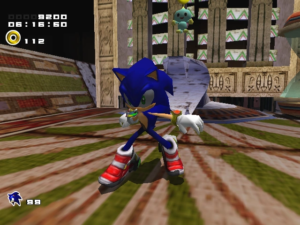
- Mission 1: This is the mission from Story Mode, where the player must reach the end of the stage or find the three hidden items in Hunting Stages. Ranking is based on score.
- Mission 2 (Collect 100 Rings!): In this mission, the player must collect 100 Rings. Ranking is based on time.
- Mission 3 (Find the lost Chao!): The player must find a hidden Neutral Chao, often located in an area accessible only by using the Mystic Melody at an Ancient Ruin. Ranking is based on time.
- Mission 4 (Finish the stage in [time]!): The player must reach the end of the stage within a set time limit. There are no Star Posts in these missions, so losing a life means starting from the beginning. Running out of time resets the stage without losing a life. Ranking is based on score.
- Mission 5 (Clear Hard Mode!): The player must complete a much harder version of the stage. Various paths are sealed off, tougher enemies are more common, there are fewer platforms over bottomless pits, and enemies may appear suddenly. Certain Level Up Items are required to progress. Ancient Ruins may only spawn 1-Ups or be removed entirely. In Hunting stages, the three items to be found are always in the same spot. Ranking is based on score.
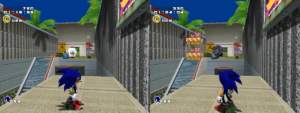
Missions are unlocked sequentially, with Mission 4 becoming accessible after beating Mission 3, which is unlocked after beating Mission 2, and so on. Completing a mission for the first time awards the player an emblem.
Kart Race
Kart Race is a racing mode that is unlocked after completing either Route 101 in the Hero story or Route 280 in the Dark story. This mode plays the same as these two stages. Each of the six playable characters—Sonic, Tails, Knuckles, Shadow, Dr. Eggman, and Rouge—has their own unique karts.
Boss
Boss Mode is unlocked after completing either the Hero or Dark story. In this mode, players face all of the bosses from the chosen story in order, similar to the Boss Sub Game from Sonic Adventure. Successfully defeating all the bosses rewards the player with an emblem.
2P Play
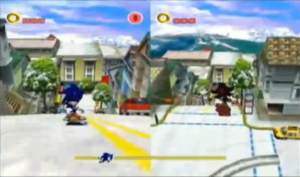
Unlike its predecessor, Sonic Adventure 2 includes a multiplayer mode called 2P Play, which features four different modes: Race, Shooting, Hunting, and Random.[10]Sonic Adventure 2 (Dreamcast) United States instruction booklet, pg. 21. Each type of stage is played split-screen, except for the shooting stages. The winning conditions for each mode are as follows:
- Race: The player who reaches the Goal Ring first wins. (Sonic/Shadow stages)
- Hunting: The first player to find the specified number of Master Emerald shards wins. (Knuckles/Rouge stages)
- Shooting: The first player to reduce their opponent’s HP Gauge to zero wins. (Tails/Dr. Eggman stages)
There is also a Kart Racing mini-game in 2P Play mode, which becomes available after clearing the Kart stages in both the Hero and Dark stories.
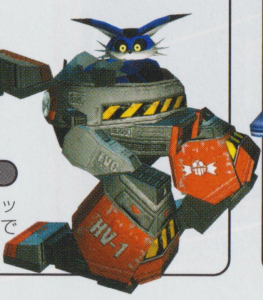
Along with the six main characters, 2P Play in Sonic Adventure 2 includes the following unlockable characters, each exclusive to 2P Play and obtainable by achieving an A-Rank in all levels of a specific main character:
- Amy Rose: Playable after achieving an A-Rank in all of Sonic’s levels.
- Metal Sonic: Playable after achieving an A-Rank in all of Shadow’s levels.
- Tikal: Playable after achieving an A-Rank in all of Knuckles’ levels.
- Chaos 0: Playable after achieving an A-Rank in all of Rouge’s levels.
- Chao: Playable after achieving an A-Rank in all of Tails’ levels.
- Big the Cat: Playable after achieving an A-Rank in all of Dr. Eggman’s levels.
Another exclusive feature in the two-player mode of Sonic Adventure 2 is alternate outfits. Players can unlock special costumes for each of the six main characters by completing all of their respective missions. Sonic and Shadow’s costumes are inspired by Phantasy Star Online, an online RPG series also developed by Sonic Team, while the other characters have unique outfits. Additionally, Sonic Adventure 2 offered seasonal costumes for Halloween and Christmas, available as DLC in late 2001.
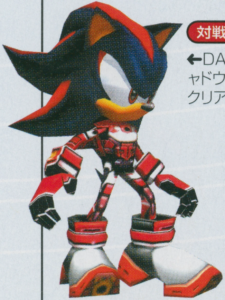
Extra
The Extra menu in Sonic Adventure 2 includes the following options:
- Tutorial: Omochao explains the game rules and mechanics.
- Basic Controls: Provides information on the basic controls for each character:
- Sonic/Shadow
- Tails/Dr. Eggman
- Knuckles/Rouge
- Chao
- Emblem Results: Displays the list of collected emblems.
- Download Event: Allows players to play downloaded events.
Options
The Options menu in Sonic Adventure 2 serves as the settings menu and includes the following options:
- Sound Test: Listen to background music.
- Change File: Switch between different saved game files.
- Change Jump Pack Setting: Adjust settings related to the jump pack.
- Change Stereo / Mono: Toggle between stereo and mono audio settings.
- Set Language for Voice and Text: Select the language for voiceovers and text.
- Change Menu Screen Theme: Adjust the theme of the menu screen.
Home Page
The Home Page option in Sonic Adventure 2 returns the player to the opening sequence of the game.
Cast
| Role | English Voice actor | Japanese Voice Actor |
|---|---|---|
| Sonic the Hedgehog | Ryan Drummond | Jun’ichi Kanemaru |
| Miles “Tails” Prower | Connor Bringas | Atsuki Murata |
| Knuckles the Echidna | Scott Dreier | Nobutoshi Canna |
| Amy Rose | Jennifer Douillard | Taeko Kawata |
Shadow the Hedgehog | David Humphrey | Kōji Yusa |
| Ryan Drummond (few lines)[11]Ryan Drummond (@RYANtheDRUMMOND) on Twitter. Twitter (October 15, 2020). Archived from the original on October 15, 2020. “SADKOOLAID: So……basically even before Jason Griffith, Sonic and Shadow were voiced by the same guy (at least for a few seconds during the final leave) this true @RYANtheDRUMMOND? / Ryan Drummond: Yup. For just that one game. Don’t tell Sega! 🤣”[12]monsoonx4 (October 18, 2020). Shadow Voice Comparison: David Humphrey and Ryan Drummond. YouTube. | ||
| Rouge the Bat | Lani Minella | Rumi Ochiai |
| Dr. Eggman | Deem Bristow | Chikao Ōtsuka |
| Omochao | Lani Minella | Etsuko Kozakura |
| Maria Robotnik | Moriah Angeline | Yuri Shiratori |
| Gerald Robotnik | Marc Biagi | Chikao Ōtsuka |
| Chao | Tomoko Sasaki | |
| President | Steve Broadie | Kinryū Arimoto |
| Secretary | Sue Wakefield | Mami Horikoshi |
GUN Soldiers | Marc Biagi | Kōji Ochiai |
| Scott Dreier | Tōru Ōkawa | |
| G.U.N. computer | Sue Wakefield | Mami Horikoshi |
| News reporter | Lani Minella | |
| Space Colony ARK computer | Scott Dreier | Tōru Ōkawa |
| Default menu theme | Shelly Fox | |
Development
Background and Conception
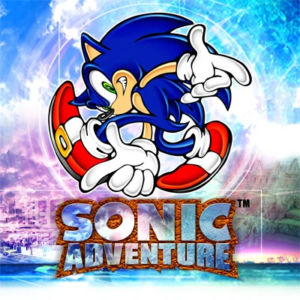
In the 1990s, Sega emerged as a major competitor in the video game market, gaining ground against Nintendo with the release of Sonic the Hedgehog in 1991. The game became a massive success, spawning a multimedia franchise including video games, cartoons, and comics. Within just two years, Sonic became more widely recognized among American children than Mickey Mouse.[13]Kent, Steven L. (2001). “The War”. The Ultimate History of Video Games. pp. 449-450. ISBN 0-7615-3643-4. “A 1993 study showed that more American kids recognized Mario and Sonic than Mickey Mouse.” However, as the decade progressed, Sega began to lose its dominance with the advent of the fifth generation of video games. Its Saturn system was overshadowed by the Nintendo 64 and Sony’s PlayStation. In a final attempt to regain ground, Sega released the Dreamcast in 1998 in Japan and 1999 worldwide. The Dreamcast was a powerful console with innovative features like online gaming.[14]“History”. The History of Sonic the Hedgehog. Les Editions Pix’n Love. September 6, 2013. pp. 54-65. ISBN 978-1-926778-96-9. Sonic Adventure was one of its launch titles and received critical acclaim. However, despite its strengths, the Dreamcast ultimately failed to compete with its rivals.
Sonic Adventure was developed by Sonic Team in Japan and was initially released in that country on December 23, 1998.[15]ドリームキャスト (Japanese). Sonic Channel. Retrieved on March 12, 2022. In 1999, several team members, including Takashi Iizuka and series co-creator Yuji Naka, relocated to the United States to develop a Western localization of the game, as the Dreamcast had not yet been released outside of Japan. This led to the establishment of Sonic Team USA (later Sega Studio USA) as a US-based division. The subdivision was created to ensure tighter control over the Sonic series’ image outside of Japan. Sonic Team felt that previous North American-produced comics and television shows had deviated from the brand’s essence, making Sonic feel like a different character.[16]Sonic the Hedgehog – Developer Interview Collection. Shmuplations.com. Retrieved on February 10, 2019. “Interviewer: Do you also oversee the direction of Sonic as a character, then? / Yuji Naka: Sonic Team checks any new Sonic thing, yeah. It’s a bit like Disney and Mickey Mouse. You’ve probably noticed that Disney hasn’t put out a movie starring Mickey for awhile. I think it’s because they’re afraid of damaging his image, and thereby ending the life of the character. Mickey is a very important character to Disney, and they hope to protect his image so that he can continue to live on for decades more. And that kind of thing has been very hard to for us with Sonic, if I’m honest. I mean, there was a Sonic cartoon broadcast in America where he has siblings. (laughs)”[17]Sonic Heroes – Developer Interview Collection. Shmuplations.com. Retrieved on July 22, 2023. “Interviewer: I imagine working in America is different from Japan? / Takashi Iizuka: Every game developer knows how the tastes of American players are very different from the Japanese, but when you actually live overseas, you come to understand that in a deeper, more direct way. I am sure that ends up being reflected in the way we make these games too. […] Another big reason for being here, is that as creators, the characters of Sonic are very precious to us. That feeling is what has brought these characters so far, but outside of Japan where we couldn’t see what’s happening, sometimes Sonic’s image was used in ways that we didn’t feel was appropriate. […] Before Sonic Adventure, some people were just doing whatever they wanted with Sonic’s image. There were comics and cartoons that were completely off-brand, he was like a totally different character. It was a tangled mess, and by re-locating Sonic Team to America, we hoped to restore some consistency.”
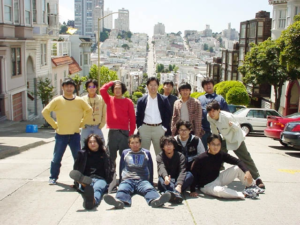
Following the release of the localized version of Sonic Adventure in mid-to-late 1999, Sega quickly demanded a sequel. Work on this new game commenced shortly thereafter. This development trajectory has drawn comparisons to Sonic the Hedgehog 2, which was developed by the Sega Technical Institute in the United States, in contrast to the first game, which was made in Japan. Development for Sonic Adventure 2 began shortly after the American release of the international version of Sonic Adventure in September 1999.[18]“History”. The History of Sonic the Hedgehog. Les Editions Pix’n Love. September 6, 2013. pp. 72-74. ISBN 978-1-926778-96-9. Takashi Iizuka served as director and art designer, while Yuji Naka took on the role of producer.[19]Sonic Team USA (June 23, 2001). Sonic Adventure 2. Dreamcast. Sega. Area/level: Credits sequence.
Gameplay
When it came to gameplay, the first task for the developers of Sonic Adventure 2 was to recreate the structure of Sonic Adventure while making it more dynamic by emphasizing action. In an effort to return to the series’ roots, the team removed the Adventure Fields from the first game to streamline the level progression. Unlike Sonic Adventure, where various gameplay elements were mixed together, Sonic Adventure 2 separated these sequences according to each character’s gameplay style.
The development team aimed to create an impressive gaming experience by ensuring the game ran at 60 frames per second with a sense of “tempo,” providing Sonic with a variety of actions rather than solely focusing on speed. The level design facilitated this flow, making Sonic appear faster than he actually was.[20]IGN staff (June 4, 2001). Interview With Sonic Adventure 2 Director Takashi Iizuka. IGN. Retrieved on February 19, 2010. Additionally, developing the game was smoother compared to Sonic Adventure due to the team’s increased familiarity with the Dreamcast’s hardware.[21]Torres, Ricardo (2 July 2001). Sonic the Hedgehog turns 10. GameSpot. Retrieved on February 16, 2014. Sonic Adventure 2 featured six different playable characters, each given roughly equal gameplay time, unlike Sonic Adventure, where Sonic’s story dominated.
Takashi Iizuka described the Chao as a “relative neutral entity” in Sonic Adventure. In the sequel, the developers expanded the presence of these creatures by introducing the ability to raise “Hero” and “Dark” Chao to reflect the conflict between good and evil. In Sonic Adventure 2, Chao have the ability to socialize, making them resemble a “real artificial life form.”
Art
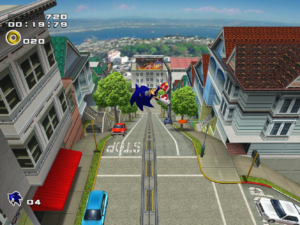
Since Sonic Team USA is located near San Francisco and its Bay Area, we discovered some magnificent locations. We decided to insert the beauty of these settings into our game.
Takashi Iizuka on the artstyle of Sonic Adventure 2.
While Sonic Adventure drew inspiration from Sonic Team’s journey through Latin America, the developers aimed to imbue Sonic Adventure 2 with an “American atmosphere.” Influenced by locations in the United States, particularly San Francisco, the team incorporated elements from the city and other American locales into the game’s design. This included references to landmarks like the Golden Gate Bridge and the San Francisco Bay Area. Additionally, the developers drew inspiration from their vacation to Yosemite National Park during the game’s development.
Characters
During the development of Sonic Adventure, the team had considered introducing a new rival for Sonic in a potential sequel, although they rarely discussed the idea. However, they found a purpose for this new character when they laid out the “good vs. evil” storyline for Sonic Adventure 2.[22]Paul.STR337 (July 18, 2011). Summer of Sonic 2011: Sonic Team on Stage. Sonic Stadium. Retrieved on July 23, 2023. The character was co-created by Takashi Iizuka and the writer of the story in Sonic Adventure 2, Shiro Maekawa.[23]006:前川 司郎 (Japanese). Sega. Archived from the original on March 8, 2016. Retrieved on July 23, 2023. Initially, the rival character’s name was “Terios,” meaning “reflection of,” as a reference to being Sonic’s doppelganger.[24]“Characters”. The History of Sonic the Hedgehog. Les Editions Pix’n Love. September 6, 2013. pp. 249. ISBN 978-1-926778-96-9. Eventually, the name was changed to Shadow the Hedgehog.
Shiro Maekawa was tasked with developing Shadow, aiming to make him just as “cool” as Sonic. Maekawa settled on the design of a black hedgehog but struggled to define his personality. One night, while brainstorming lines for a scene in which Sonic confronts Shadow for impersonating him, Maekawa came up with Shadow’s first line: “Hmph, aren’t you the fake one here?” To further shape his “subtle” character, Maekawa envisioned Shadow would refer to himself with the more humble Japanese pronoun “boku.”
Another character, Rouge the Bat, was created to contrast Knuckles. Interestingly, her original name was “Shadow” before being changed to the current one.[25]Sonic the Hedgehog (2018). Sonic the Hedgehog on Tumblr. Tumblr. Retrieved on March 20, 2023. “#except that initially rouge was called shadow #and then shadow became shadow #and the earlier shadow became rouge #it’s not confusing at all!”
Promotion
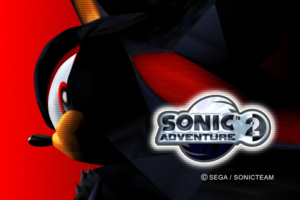
Sega announced plans for a follow-up to Sonic Adventure, along with a spin-off that would become Sonic Shuffle, on October 4, 1999.[26]IGN Staff (October 4, 1999). Sega Speaks Out on Sonic Adventure Follow-up. IGN. Retrieved on February 26, 2014. The newly named Sonic Adventure 2 made its first appearance at E3 on May 11, 2000,[27]Sonic Adventure 2 Unveiled. SonicTeam.com. Archived from the original on February 8, 2001. Retrieved on February 21, 2022. and Sonic Team added the video shown at E3 to its website on June 30.[28]Gantayat, Anoop (June 30, 2000). First Direct Feed Footage of Sonic Adventure 2. IGN. Retrieved on February 15, 2014. On May 30, 2001, Sonic Team posted a trailer and several screenshots of the game.[29]IGN Staff (May 31, 2001). New Sonic Adventure 2 Trailer and Screens. IGN. Retrieved on February 15, 2014. Sega promoted Sonic Adventure 2 as the last Sonic game for the Dreamcast and as a celebration of the series’ tenth anniversary.[30]Fulljames, Steve (July/August 2001). “Sonic Adventure 2“. Official Dreamcast Magazine (21): 8–19. Archived from the original. Retrieved on February 21, 2022. In June 2001, Sega held a tenth anniversary party for Sonic, where attendees could compete in a battle tournament, with the winner playing against Takashi Iizuka himself.
Sonic Adventure 2 was released worldwide on June 23, 2001,[31]SONIC ADVENTURE 2. Sonic Team. Archived from the original on December 11, 2001. marking the Sonic series’ tenth anniversary. A special collector’s edition of the game was produced, featuring a large blue case that contained the game, a music CD with tracks spanning Sonic’s ten-year history, a Sonic the Hedgehog retrospective booklet, and a commemorative coin.
Pre-release
Main article: Sonic Adventure 2: The Trial
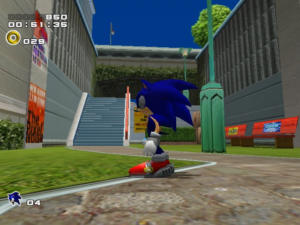
A demo version of Sonic Adventure 2, titled Sonic Adventure 2: The Trial, was distributed as a bonus to those who purchased the first copies of Phantasy Star Online.[32]PHANTASY STAR ONLINE (Japanese). Sega. Archived from the original on April 20, 2009. Retrieved on February 20, 2022. “The first press version includes the trial version of “SONIC ADVENTURE 2″.”[33]“Access All Games: Sonic Adventure 2“. Computer and Video Games (232): 8. March 2001. Archived from the original. Retrieved on February 21, 2022. Since Phantasy Star Online was released in late 2000 in Japan and early 2001 in Western regions, this bonus disc served to build excitement for the final release of Sonic Adventure 2 just six months later. The demo version included only one stage, City Escape, and a rudimentary two-player mode that was accessible through hacks.
A notable difference between Sonic Adventure 2: The Trial and the final version of Sonic Adventure 2 is that Sonic is missing the Grind Shoes in the demo. This is because Sega’s partnership with Soap, the company known for its grind shoes, was established late in the game’s development.
Advertisement
Sonic Adventure 2 is known for its infamous commercial featuring a humorous and dark parody of a scene from Jurassic Park. In the commercial, a scientist is seen approaching a tank labeled “Good Hedgehog” and petting a friendly hedgehog. The camera then shifts to a tank labeled “Bad Hedgehog,” where a cow is being lowered in. Eating sounds and the cow’s screams can be heard, followed by the screen cutting back to the “Bad Hedgehog” tank where the hedgehog burps. This shocking and memorable advertisement played on the game’s theme of good versus evil.
Soundtrack
Main articles: Multi-Dimensional Sonic Adventure 2 Original Sound Track, Cuts Unleashed: SA2 Vocal Collection, Sonic Adventure 2 Official Soundtrack, Sonic Adventure 2 Original Soundtrack 20th Anniversary Edition, and SONIC ADVENTURE 2 OFFICIAL SOUNDTRACK VINYL EDITION
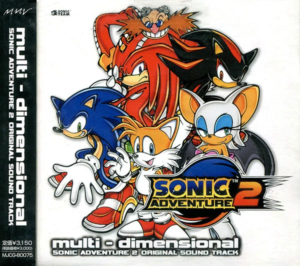
The main theme of Sonic Adventure 2 is “Live and Learn,” performed by Crush 40. Some of the character themes are remixes of their counterparts from Sonic Adventure. Five soundtracks have been released for Sonic Adventure 2:
- Multi-Dimensional Sonic Adventure 2 Original Sound Track: Contains all the music tracks from the game except for the character themes.
- Cuts Unleashed: SA2 Vocal Collection: Includes all character theme songs and “Live and Learn”.
- Sonic Adventure 2 Official Soundtrack: The western-released soundtrack that features all character themes and some action stage themes.
- Sonic Adventure 2 Battle – Sampler: A promotional disc with tracks from Cuts Unleashed, but all track durations are halved.
- Sonic Adventure 2 Original Soundtrack 20th Anniversary Edition: Celebrates the 20th anniversary of the Sonic series with both vocal and instrumental tracks from the game.
- SONIC ADVENTURE 2 OFFICIAL SOUNDTRACK VINYL EDITION: A vinyl album consisting of two records with a selection of both vocal and instrumental music tracks from the game.
Reception
Sonic Adventure 2 received critical acclaim, scoring 89% on Metacritic and 83.3% on GameRankings . Critics praised the game’s variety of gameplay styles. Edge and GamePro’s Four-Eyed Dragon appreciated the three core styles and bonus features like Chao gardens for their engagement . Game Revolution’s Johnny Liu highlighted the replay value from multiple playing styles and 180 different goals . IGN’s Anthony Chau called it “one of the best Sonic games ever” and noted its significance in the Dreamcast’s lineup .
Criticisms
Shahed Ahmed of GameSpot criticized the camera for forcing players to jump to out-of-frame platforms, a common issue in 3D platformers. While players could re-orient the camera with trigger buttons, it reverted when the character moved . Chau and Liu mentioned that camera issues were minor in Tails and Dr. Eggman’s levels but frustrating in Knuckles and Rouge’s stages . Edge noted that camera problems were pervasive and showed little improvement from Sonic Adventure .
Praise
The game’s graphics received widespread praise. Liu called them “sweet, sweet eye-crack” . Four-Eyed Dragon praised the detailed backgrounds and extensive color palettes of characters and enemies . Chau highlighted the game’s textures and visual appeal, calling it one of the most beautiful Dreamcast games . The texture detail and draw distance also impressed Edge . Additionally, Chau, Liu, and Ahmed lauded the game’s 60-frame-per-second rendering speed .
Music and Voice Acting
Ahmed noted the music was a step up from Sonic Adventure‘s “campy glam-rock and J-pop soundtrack,” with less emphasis on lyrics . Liu appreciated its more understated approach . Four-Eyed Dragon praised the eclectic mix of orchestrated masterpieces, guitar tunes, and melodic hip-hop, which filled the game’s ambiance perfectly . The reaction to the voice acting was mixed; Ahmed found it well-executed, particularly the lip-synching , but Liu and Chau preferred the Japanese voices over the English ones .
Plot
Ahmed criticized the plot for becoming scattered and lackluster as the game progressed . Liu agreed, noting that despite its ambitious scope, it failed to advance the series’ core plot beyond the Sega Mega Drive games . Edge, however, appreciated the dual-perspective presentation from both the hero and villain sides .
Accolades
- Sonic Adventure 2 received several accolades, including IGN’s Editors’ Choice Award in 2001.[34]Game Reviews. IGN. Retrieved on December 28, 2014.
- ScrewAttack ranked it as the fifth-best Dreamcast game.[35]Top 10 Dreamcast Games. ScrewAttack. Retrieved on July 22, 2013.
- GamesRadar rated it the tenth-greatest Dreamcast game out of 25.[36]GamesRadar Staff (19 April 2012). Best Dreamcast games of all time. GamesRadar. Retrieved on February 2, 2013.
- In February 2014, IGN’s Luke Karmali listed it as his tenth-favorite game of all time.[37]Karmali, Luke (February 15, 2014). Luke Karmali’s Top 10 Games of All Time. IGN. Retrieved on December 28, 2014.
- WatchMojo ranked it as the best 3D Sonic game and the fourth-best Sonic game overall.[38]Reynolds, Johnny (2022). Top 20 Best Sonic The Hedgehog Games. WatchMojo. Retrieved on December 19, 2022.
Re-Releases
Adaptations
The anime series Sonic X included a six-episode adaptation of the game’s events between “Project: Shadow” and “Showdown in Space,” known as the Shadow Saga. Like its predecessor, the adaptation was mostly faithful to the game’s plot, with the Japanese version even being a word-for-word adaptation at some points. However, parts were written in for characters that did not appear in Sonic Adventure 2 such as Christopher Thorndyke and Cream the Rabbit.
In Sonic the Hedgehog #98, published by Archie Comics, a two-part adaptation of Sonic Adventure 2 was presented, written by Karl Bollers and Ken Penders.
Sonic the Hedgehog 3 will be heavily inspired by the game itself by its elements.
Trivia
- The two driving levels in the game’s story, Route 101 and Route 280, are named after real-world U.S. highways.
- This is the first Sonic game to have swearing in the English track. Swear words can be heard in the lyrics of the main theme of Knuckles the Echidna and in the lyrics for the background music of some of the stages he goes through (i.e., “Deeper”). This was also the main reason why the GameCube version has a “Lyrics” warning on the ESRB rating.
- In the game, Dr. Eggman blows up half of the moon, but in later games with cutscenes in outer space scenes, most notably Shadow the Hedgehog and Sonic Colors, it is still perfectly intact. Also, the earth does not appear to have any gravitational stress caused by the destruction. However, as recently confirmed by Takashi Iizuka of Sonic Team at Sonic Boom 2013, in all later games after Sonic Adventure 2, the moon is actually still blown up. However, from Sonic Heroes onwards, the intact side of the moon is shown, while the part that Eggman blew up is on the opposite side of the moon.
- Sonic Adventure 2 is the only game where Sonic wears the Grind Shoes in order to promote the Soap product which the Grind Shoes were based on, along with the new extreme sport, freestyle grinding, that the shoes were made for. There are also many billboards, blimps, and benches in the game that advertised the shoes. The Grind Shoes themselves are a custom version of the Scorcher/Nitro Soap Shoe, while Shadow wears a pair of custom Broadside Soap shoes, as grinding (or “soaping”) debuted as an important new gameplay element.
- This is the first non-spin-off game where Dr. Eggman is playable.
- In the first cutscene of the Hero Story, the pilot of the G.U.N. helicopter identifies himself in military talk as “Sigma-Alpha 2,” which translates from Greek as “SA2,” the game’s initials.
- This marks the final Sonic game for the Dreamcast.
- This is the last Sonic game to be featured on a Sega console, as Sega eventually withdrew from the console market after the release of this game.
- If one were to go to the Theme Select in the Options menu and rotate the Control Stick clockwise for a few moments until hearing a chime sound, they would then see a picture of the President’s Secretary and will then be able to select the Secretary’s menu theme.
- Like Sonic Adventure, in the original Dreamcast version of the game if you insert the disk into a PC, special wallpapers will be available to download as an Easter egg. As well as that, there is a list of main series Sonic games prior to Sonic Adventure 2, although Sonic the Hedgehog CD is absent from the list.
- The camera can be used to move objects in the game. This is most noticeable in the Chao Garden if the player has a fruit in front of the camera and they walk away from it. The same thing can be done in the Chao Garden in Sonic Adventure.
- In the first cutscene of the demo version, before the player enters City Escape, the man on the radio says, “What the hell?” in the text. This marks the first Sonic game to have profanity in a character’s dialogue, although this is not in the final release of this game. In the final release, the script instead says, “What?!”
- Shadow has the least amount of stages out of all the characters, with only four (Radical Highway, Sky Rail, White Jungle, and Final Chase).
- This is the only Sonic game where Connor Bringas voices Tails.
- The “Chao in Space 2” movie billboard, as well as the billboard advertising for the DVD Edition of “Chao in Space” in City Escape, refers to the “Chao in Space” movie billboard near the entrance of Casinopolis in Sonic Adventure. In the Chao in Space 2 poster, the rating is PG-13 as part of MPAA.
- Sonic features the most Level Up Items out of the playable characters in Sonic Adventure 2, with a maximum of six. Knuckles and Eggman have five Level Up Items, and Tails, Shadow, and Rouge have a minimum of four.
- The Dreamcast version of the game runs a disc check to make sure it is not run from a copied disc. If this check fails, Eggman will fall through the floor when he starts his section of Cannon’s Core.[56]https://www.youtube.com/watch?v=sORf5oWvAA4
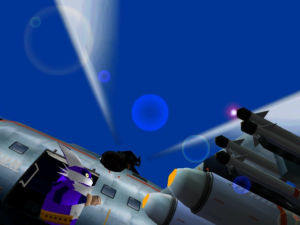
- Big the Cat has six known cameo appearances in the cutscenes of Sonic Adventure 2 that can only be seen by pressing
 . These include:
. These include:- During Sonic’s escape from the helicopter at the beginning of the Hero story, Big can be seen in the Dreamcast version holding onto it.
- During Sonic and Shadow’s first meeting, Big can be seen running around Shadow while he is standing over the F-6t Big Foot.
- In the cutscene after Knuckles fought King Boom Boo, Big can be seen standing behind the entrance to the shuttle once the entrance opens.
- During the cutscene after Knuckles and Rouge’s fight, Big can be seen wandering around the arena.
- During the Last Story’s intro, Big can be seen standing on the computer’s platform with Eggman.
- In the Last Story, before Amy tries to persuade Shadow to help, Big can be seen running right and left in the hallway that leads to the main room.
- Shiro Maekawa has stated that he found difficulty in writing the story for Sonic Adventure 2. Despite this, the game’s story stands as Maekawa’s favorite as he is emotionally attached to it, as it is the first story he wrote for a Sonic game.
- Maekawa has stated that if he had a chance to rewrite it or change something about the game’s story, he would only add back the scenes he had to cut.[57]Windii (June 23, 2018). The Supreme Topic of ‘Other’ Knowledge. Sonic Retro. Retrieved on June 23, 2018.
- According to Takashi Iizuka, Sonic Adventure 2 is the best Sonic game as of July 2022.[58]Sonic Frontiers: 123 Rapid-Fire Questions With Takashi Iizuka. YouTube. Game Informer (July 12, 2022). Retrieved on July 23, 2022.
- Sonic Adventure 2 is the game with the most original lyrical arrangements in the franchise, with a total of 18.
- Utilizing an exploit, one has the potential to strike the G.U.N. truck during the City Escape stage by employing the homing dash maneuver directly towards the G.U.N. truck.
- The logo for Sonic Movie 3 is based on the logo of Sonic Adventure 2.
Archive Links
References
- ↑ Updated Dreamcast release list. Gamespot (June 4, 2001). Retrieved on March 14, 2024.
- ↑ SONIC ADVENTURE 2. Sega (December 11, 2001). Archived from the original on December 11, 2001. Retrieved on June 18, 2019.
- ↑ Sonic Adventure 2 (Dreamcast) United States instruction booklet, pg. 6.
- ↑ Sonic Adventure 2 (Dreamcast) United States instruction booklet, pg. 7.
- ↑ Sonic Adventure 2 (Dreamcast) United States instruction booklet, pg. 8.
- ↑ Sonic Adventure 2 (Dreamcast) United States instruction booklet, pg. 9.
- ↑ Sonic Adventure 2 (Dreamcast) United States instruction booklet, pgs. 10.
- ↑ Sonic Adventure 2 (Dreamcast) United States instruction booklet, pgs. 11.
- ↑ Sonic Adventure 2 (Dreamcast) United States instruction booklet, pg. 12.
- ↑ Sonic Adventure 2 (Dreamcast) United States instruction booklet, pg. 21.
- ↑ Ryan Drummond (@RYANtheDRUMMOND) on Twitter. Twitter (October 15, 2020). Archived from the original on October 15, 2020. “SADKOOLAID: So……basically even before Jason Griffith, Sonic and Shadow were voiced by the same guy (at least for a few seconds during the final leave) this true @RYANtheDRUMMOND? / Ryan Drummond: Yup. For just that one game. Don’t tell Sega! 🤣”
- ↑ monsoonx4 (October 18, 2020). Shadow Voice Comparison: David Humphrey and Ryan Drummond. YouTube.
- ↑ Kent, Steven L. (2001). “The War”. The Ultimate History of Video Games. pp. 449-450. ISBN 0-7615-3643-4. “A 1993 study showed that more American kids recognized Mario and Sonic than Mickey Mouse.”
- ↑ “History”. The History of Sonic the Hedgehog. Les Editions Pix’n Love. September 6, 2013. pp. 54-65. ISBN 978-1-926778-96-9.
- ↑ ドリームキャスト (Japanese). Sonic Channel. Retrieved on March 12, 2022.
- ↑ Sonic the Hedgehog – Developer Interview Collection. Shmuplations.com. Retrieved on February 10, 2019. “Interviewer: Do you also oversee the direction of Sonic as a character, then? / Yuji Naka: Sonic Team checks any new Sonic thing, yeah. It’s a bit like Disney and Mickey Mouse. You’ve probably noticed that Disney hasn’t put out a movie starring Mickey for awhile. I think it’s because they’re afraid of damaging his image, and thereby ending the life of the character. Mickey is a very important character to Disney, and they hope to protect his image so that he can continue to live on for decades more. And that kind of thing has been very hard to for us with Sonic, if I’m honest. I mean, there was a Sonic cartoon broadcast in America where he has siblings. (laughs)”
- ↑ Sonic Heroes – Developer Interview Collection. Shmuplations.com. Retrieved on July 22, 2023. “Interviewer: I imagine working in America is different from Japan? / Takashi Iizuka: Every game developer knows how the tastes of American players are very different from the Japanese, but when you actually live overseas, you come to understand that in a deeper, more direct way. I am sure that ends up being reflected in the way we make these games too. […] Another big reason for being here, is that as creators, the characters of Sonic are very precious to us. That feeling is what has brought these characters so far, but outside of Japan where we couldn’t see what’s happening, sometimes Sonic’s image was used in ways that we didn’t feel was appropriate. […] Before Sonic Adventure, some people were just doing whatever they wanted with Sonic’s image. There were comics and cartoons that were completely off-brand, he was like a totally different character. It was a tangled mess, and by re-locating Sonic Team to America, we hoped to restore some consistency.”
- ↑ “History”. The History of Sonic the Hedgehog. Les Editions Pix’n Love. September 6, 2013. pp. 72-74. ISBN 978-1-926778-96-9.
- ↑ Sonic Team USA (June 23, 2001). Sonic Adventure 2. Dreamcast. Sega. Area/level: Credits sequence.
- ↑ IGN staff (June 4, 2001). Interview With Sonic Adventure 2 Director Takashi Iizuka. IGN. Retrieved on February 19, 2010.
- ↑ Torres, Ricardo (2 July 2001). Sonic the Hedgehog turns 10. GameSpot. Retrieved on February 16, 2014.
- ↑ Paul.STR337 (July 18, 2011). Summer of Sonic 2011: Sonic Team on Stage. Sonic Stadium. Retrieved on July 23, 2023.
- ↑ 006:前川 司郎 (Japanese). Sega. Archived from the original on March 8, 2016. Retrieved on July 23, 2023.
- ↑ “Characters”. The History of Sonic the Hedgehog. Les Editions Pix’n Love. September 6, 2013. pp. 249. ISBN 978-1-926778-96-9.
- ↑ Sonic the Hedgehog (2018). Sonic the Hedgehog on Tumblr. Tumblr. Retrieved on March 20, 2023. “#except that initially rouge was called shadow #and then shadow became shadow #and the earlier shadow became rouge #it’s not confusing at all!”
- ↑ IGN Staff (October 4, 1999). Sega Speaks Out on Sonic Adventure Follow-up. IGN. Retrieved on February 26, 2014.
- ↑ Sonic Adventure 2 Unveiled. SonicTeam.com. Archived from the original on February 8, 2001. Retrieved on February 21, 2022.
- ↑ Gantayat, Anoop (June 30, 2000). First Direct Feed Footage of Sonic Adventure 2. IGN. Retrieved on February 15, 2014.
- ↑ IGN Staff (May 31, 2001). New Sonic Adventure 2 Trailer and Screens. IGN. Retrieved on February 15, 2014.
- ↑ Fulljames, Steve (July/August 2001). “Sonic Adventure 2“. Official Dreamcast Magazine (21): 8–19. Archived from the original. Retrieved on February 21, 2022.
- ↑ SONIC ADVENTURE 2. Sonic Team. Archived from the original on December 11, 2001.
- ↑ PHANTASY STAR ONLINE (Japanese). Sega. Archived from the original on April 20, 2009. Retrieved on February 20, 2022. “The first press version includes the trial version of “SONIC ADVENTURE 2″.”
- ↑ “Access All Games: Sonic Adventure 2“. Computer and Video Games (232): 8. March 2001. Archived from the original. Retrieved on February 21, 2022.
- ↑ Game Reviews. IGN. Retrieved on December 28, 2014.
- ↑ Top 10 Dreamcast Games. ScrewAttack. Retrieved on July 22, 2013.
- ↑ GamesRadar Staff (19 April 2012). Best Dreamcast games of all time. GamesRadar. Retrieved on February 2, 2013.
- ↑ Karmali, Luke (February 15, 2014). Luke Karmali’s Top 10 Games of All Time. IGN. Retrieved on December 28, 2014.
- ↑ Reynolds, Johnny (2022). Top 20 Best Sonic The Hedgehog Games. WatchMojo. Retrieved on December 19, 2022.
- ↑ Sonic Adventure 2. GameRankings. Retrieved on February 9, 2014.
- ↑ Sonic Adventure 2 for Dreamcast Reviews. Metacritic (November 25, 2014).
- ↑ Sonic Adventure 2. Edge. Archived from the original on February 8, 2002. Retrieved on December 28, 2014.
- ↑ “Dreamcast: Sonic Adventure 2” (in Japanese). Famitsu (Weekly Famitsu Cross Review 2001 Perfect Guide): 100. April 2002. Archived from the original. Retrieved on February 22, 2022.
- ↑ Four-Eyed Dragon (June 19, 2001). Sonic Adventure 2. GamePro. Archived from the original on January 2, 2006. Retrieved on February 9, 2014.
- ↑ Four-Eyed Dragon (June 19, 2001). Sonic Adventure 2. GamePro. Archived from the original on January 2, 2006. Retrieved on February 9, 2014.
- ↑ Ahmed, Shahed (June 19, 2001). Sonic Adventure 2 Review. GameSpot. Retrieved on December 27, 2014.
- ↑ Ayinde, Modupe (June 20, 2001). Sonic Adventure 2 Review. GameSpot UK. Archived from the original on June 25, 2001. Retrieved on February 21, 2022.
- ↑ Shea, Cam (September 2001). “Sonic Adventure 2“. Hyper (95): 60-61. Archived from the original. Retrieved on February 21, 2022.
- ↑ Chau, Anthony (June 22, 2001). Sonic Adventure 2 Review. IGN. Retrieved on November 2, 2014.
- ↑ Fulljames, Steve (July/August 2001). “Sonic Adventure 2“. Official Dreamcast Magazine (21): 8–19. Archived from the original. Retrieved on February 21, 2022.
- ↑ Mathers, Martin (July 2001). “review Sonic Adventure 2“. Dreamcast Magazine (UK) (24): 34–41. Archived from the original. Retrieved on February 21, 2022.
- ↑ Combo, Chris (August 2001). “Walkthrough: Sonic Adventure 2” (in Portuguese). Super Game Power (89): 56. Archived from the original. Retrieved on February 21, 2022.
- ↑ “Test: Sonic Adventure 2” (in French). Consoles + (114): 112-113. July/August 2001. Archived from the original. Retrieved on February 22, 2022.
- ↑ Gäbel, Colin; Schultes, Oliver (August 2001). “Test: Sonic Adventure 2” (in German). MAN!AC: 44–46. Archived from the original. Retrieved on February 22, 2022.
- ↑ “Review: Dreamcast” (in Japanese). Dorimaga: 30. October 11, 2002. Archived from the original. Retrieved on February 22, 2022.
- ↑ Halverson, Dave (August 2001). “Reviews: Sonic Adventure 2“. Gamers’ Republic (36): 46-47. Archived from the original. Retrieved on February 22, 2022.
- ↑ https://www.youtube.com/watch?v=sORf5oWvAA4
- ↑ Windii (June 23, 2018). The Supreme Topic of ‘Other’ Knowledge. Sonic Retro. Retrieved on June 23, 2018.
- ↑ Sonic Frontiers: 123 Rapid-Fire Questions With Takashi Iizuka. YouTube. Game Informer (July 12, 2022). Retrieved on July 23, 2022.
External Links
- Official Japanese website (Archived)
- Official English website (Archived)
- Product page at the Japanese Sega website (Archived) (archived)
